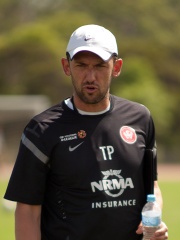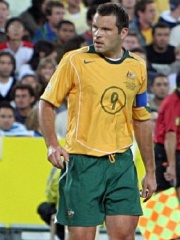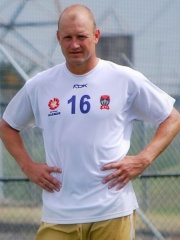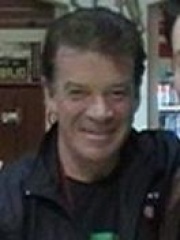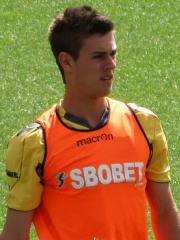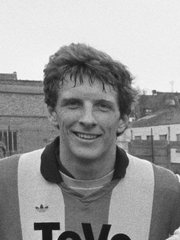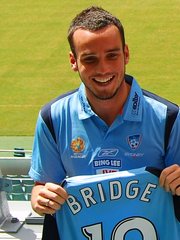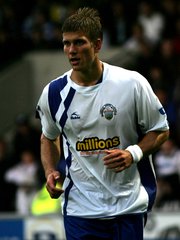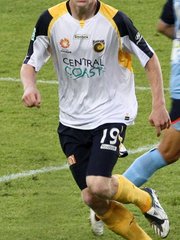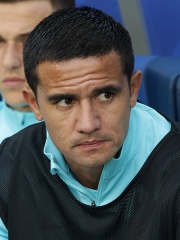

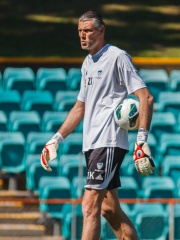
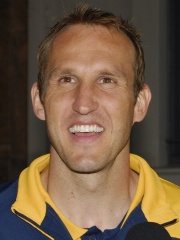
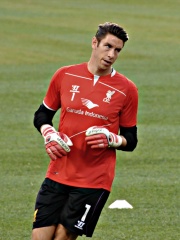
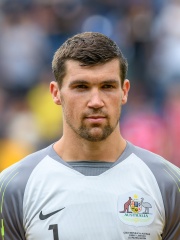
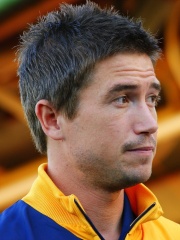
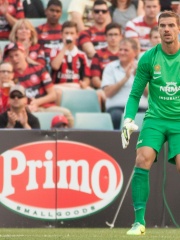
The Most Famous
SOCCER PLAYERS from Australia
This page contains a list of the greatest Australian Soccer Players. The pantheon dataset contains 21,273 Soccer Players, 170 of which were born in Australia. This makes Australia the birth place of the 31st most number of Soccer Players behind Hungary, and South Korea.
Top 10
The following people are considered by Pantheon to be the top 10 most legendary Australian Soccer Players of all time. This list of famous Australian Soccer Players is sorted by HPI (Historical Popularity Index), a metric that aggregates information on a biography's online popularity. Visit the rankings page to view the entire list of Australian Soccer Players.

1. Tim Cahill (b. 1979)
With an HPI of 65.51, Tim Cahill is the most famous Australian Soccer Player. His biography has been translated into 61 different languages on wikipedia.
Timothy Filiga Cahill (Samoan: [fiˈli.ŋa]; ; born 6 December 1979) is an Australian former professional soccer player who played as an attacking midfielder but also played as a striker on many occasions. A box-to-box midfielder, Cahill became recognised for "his aggressive and powerful approach and his ability to head the ball in the penalty area". Cahill has scored 50 goals in 108 caps between 2004 and 2018 and is regarded as one of the greatest Australian soccer players of all time. He currently works as a pundit for BBC Sport and Sky Sports. In 1997, Cahill left Sydney for England to play professionally; there he was signed by Millwall on a free transfer from Sydney United. He was part of the Millwall side that won the Football League Second Division title in the 2000–01 season, and was also a central part of Millwall's run to the 2004 FA Cup Final. Before the start of the 2004–05 season, Cahill was transferred to Premier League club Everton. He was named both Everton Player of the Season and Everton Players' Player of the Season in his debut season, and in the following year he was named as one of 50 nominees for the Ballon d'Or, becoming the first Everton player in 11 years to be nominated. He was also part of the Everton side that reached the final of the 2008–09 FA Cup. After leaving Everton in 2012, Cahill played for the New York Red Bulls in Major League Soccer and Chinese Super League sides Shanghai Shenhua and Hangzhou Greentown, before returning to Australia to play for Melbourne City in the A-League. After a brief spell at former club Millwall, he ended his career in the Indian Super League with Jamshedpur. Cahill was the first Australian to score at a FIFA World Cup, scored in three World Cups (2006, 2010, and 2014) and has scored the most goals by any Australian in the men's World Cup with five goals. In 2007, he became the first Australian player to score at an AFC Asian Cup. Cahill is known for his adept heading ability and high vertical leap, having scored many of his goals with his head. He is famous for his regular goal celebration of shadow boxing around the corner flag.

2. Ned Zelic (b. 1971)
With an HPI of 56.17, Ned Zelic is the 2nd most famous Australian Soccer Player. His biography has been translated into 45 different languages.
Nedjeljko Zelic (born 4 July 1971), commonly known as Ned Zelic, is an Australian former footballer who played as a centre-back or defensive midfielder.

3. Zeljko Kalac (b. 1972)
With an HPI of 55.64, Zeljko Kalac is the 3rd most famous Australian Soccer Player. His biography has been translated into 34 different languages.
Zeljko Kalac (born 16 December 1972) is an Australian soccer coach and former player who is currently the goalkeeping coach for the Iraq national football team. Standing at 2.02 m, Kalac is the tallest player to have represented the Australia national football team. Kalac's 24-year playing career included spells for football clubs in England, the Netherlands, Italy and Greece. Although he was a goalkeeper, Kalac's preferred playing number (when not the conventional number 1) is 18 and has generally worn this number when playing for Australia.

4. Mark Schwarzer (b. 1972)
With an HPI of 55.48, Mark Schwarzer is the 4th most famous Australian Soccer Player. His biography has been translated into 52 different languages.
Mark Schwarzer ( SHWORT-sər, German: [ˈʃvaʁt͡sɐ]; born 6 October 1972) is an Australian former professional football player who played as a goalkeeper. He represented Australia at international level from 1993 to 2013, and was selected for both the 2006 and 2010 FIFA World Cups. Having progressed through the youth ranks of Colo Cougars, Penrith, Blacktown Association and Marconi Stallions, Schwarzer turned professional for National Soccer League side Marconi Stallions in 1990. After making 58 appearances for the club, he moved to German Bundesliga side Dynamo Dresden in 1994, appearing twice, and then to Bundesliga side 1. FC Kaiserslautern in 1995, appearing four times. Schwarzer joined then-second-tier side Bradford City in 1996 and made 16 appearances before joining Premier League club Middlesbrough in February 1997. He made 445 appearances for Middlesbrough, but decided to leave the club in May 2008. He then switched to Premier League side Fulham, and made 218 appearances for the club until he moved to Chelsea in 2013. He was the first – and, to date, only – non-Briton to have made more than 500 Premier League appearances (making him the highest-appearing non-Briton in the Premier League's history), and also the oldest player to have played in the knockout stages of the UEFA Champions League. He joined Leicester City on a free transfer in January 2015 and left the club at the end of their 2015–16 Premier League-winning season. Having played for Australia at under-17 and under-20 level, Schwarzer made his full international debut in a World Cup qualifying match against Canada in 1993 as a substitute after Robert Zabica was sent off in the 17th minute. During the course of his international career, he won a total of 109 caps for his country. He became Australia's most capped male player when he surpassed Alex Tobin's appearance record in January 2011.
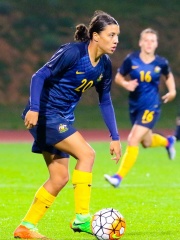
5. Sam Kerr (b. 1993)
With an HPI of 54.65, Sam Kerr is the 5th most famous Australian Soccer Player. Her biography has been translated into 34 different languages.
Samantha May Kerr (born 10 September 1993) is an Australian professional soccer player who plays as a striker for Women's Super League club Chelsea, and the Australia women's national team, which she has captained since 2019. Known for her speed, skill, and tenacity, Kerr is widely considered one of the best strikers in the world, and one of Australia's greatest athletes. Kerr is the all-time leading Australian international scorer, with 69 international goals, and was the all-time leading scorer in the National Women's Soccer League (NWSL) in the United States until 2024. She is the only female soccer player to have won the Golden Boot in three different leagues and on three different continents—the W-League (Australia/New Zealand) in 2017–18 and 2018–19, the NWSL (North America) in 2017, 2018, and 2019, and the Women's Super League (Europe) in 2020–21 and 2021–22. Kerr started her career at the age of 15 with Perth Glory where she played from 2008 to 2012, before moving to Sydney FC. In 2013, she joined the Western New York Flash for the inaugural season of the NWSL and helped lead the team to win the NWSL Shield. She later played for Sky Blue FC and the Chicago Red Stars in the same league. In 2019, Kerr indicated her interest to play in Europe, and having fielded multiple offers from clubs such as Olympique Lyonnais, Kerr ultimately signed with Chelsea, so far winning 8 trophies with the club, including back-to-back-to-back Women's Super League titles, as well as helping the team reach the UEFA Women's Champions League final for the first time in 2021. Kerr earned her first senior international cap in 2009 at the age of 15 and has since represented Australia at the 2010, 2014, 2018, and 2022 AFC Women's Asian Cup tournaments, the 2011, 2015, 2019, and 2023 FIFA Women's World Cups, and the 2016 and 2020 Summer Olympics. During the 2019 World Cup, she became the first Australian player to score a hat-trick at a World Cup tournament. In 2021, she captained the team to their historic first ever semi-final of a major tournament during the delayed 2020 Summer Olympics, resulting in their best ever fourth-place finish.

6. Brad Jones (b. 1982)
With an HPI of 54.52, Brad Jones is the 6th most famous Australian Soccer Player. His biography has been translated into 35 different languages.
Bradley Scott Jones (born 19 March 1982) is an Australian former professional footballer who played as a goalkeeper. He was a member of the Middlesbrough team for over a decade often playing on loan at a succession of lower league clubs: Stockport County, Rotherham United, Blackpool and Sheffield Wednesday. He also had a brief loan spell in Ireland with Shelbourne. In August 2010, he made a £2.3 million move to Liverpool where he spent four seasons, mostly in a back-up role. Jones then had two short stints, his final in England at Bradford City and then in the Netherlands at NEC, before joining Feyenoord on a one-year deal in August 2016. On 22 May 2017, he signed for another two years at Feyenoord following their title win in the Dutch Eredivisie.

7. Mathew Ryan (b. 1992)
With an HPI of 54.12, Mathew Ryan is the 7th most famous Australian Soccer Player. His biography has been translated into 43 different languages.
Mathew David Ryan (born 8 April 1992) is an Australian professional soccer player who currently plays as a goalkeeper for La Liga club Levante and captains the Australia national team. Born in Sydney, Ryan played youth football for Marconi Stallions, Blacktown City and Central Coast Mariners. He made his senior debut for Blacktown before moving to the Mariners' senior squad in 2010. In 2013, Ryan moved to Club Brugge, where he played for two years before joining Valencia. Ryan made his senior international debut in 2012, and has since established himself as Australia's first-choice goalkeeper, effectively succeeding his childhood idol Mark Schwarzer. He played at the FIFA World Cup in 2014, 2018, and 2022, as well as the AFC Asian Cup in 2015, 2019 and 2023, winning the Best Goalkeeper award at the 2015 tournament which his country won on home soil.

8. Harry Kewell (b. 1978)
With an HPI of 53.90, Harry Kewell is the 8th most famous Australian Soccer Player. His biography has been translated into 45 different languages.
Harry Kewell (born 22 September 1978) is an Australian soccer coach, manager and former player. He is currently the head coach of V.League 1 club Hanoi FC. As a domestic player, Kewell represented Leeds United, Liverpool, Galatasaray, Melbourne Victory, Al-Gharafa and Melbourne Heart. While at Leeds, he was named the PFA Young Player of the Year in 2000. Internationally, he received 58 caps and scored 17 goals while playing for Australia. A left winger also capable of playing as an attacking midfielder or second striker, he is often regarded within the media as "Australia's finest soccer export", despite his career being blighted with injury. In 2012, Kewell was named Australia's greatest soccer player in a vote by Australian fans, players and media. Kewell scored a goal against Croatia which took Australia through to the knockout stages of the 2006 FIFA World Cup, the Australian national team's second World Cup. He is a member of the Executive Committee of the Australian Professional Footballers' Association. Kewell also has a British passport through his father's heritage. Former Middlesbrough midfielder-turned pundit Robbie Mustoe named Kewell as one of the greatest players he had played against but questioned his consistency and attitude after his initial injuries. Former German international Michael Ballack has also highlighted Kewell's ability and inconsistency. Kewell has represented Australia at the 1995 FIFA U-17 World Championship, the 1997 FIFA Confederations Cup, where Australia finished runners-up, the 2004 OFC Nations Cup, which Australia claimed for the fourth time, the 2006 FIFA World Cup, the 2007 AFC Asian Cup, the 2010 FIFA World Cup and the 2011 AFC Asian Cup, where Australia finished runners-up. To date, Kewell is the only Australian man to have ever played in the UEFA Champions League final, being part of Liverpool's squad that won the 2005 UEFA Champions League final.

9. Ante Covic (b. 1975)
With an HPI of 53.57, Ante Covic is the 9th most famous Australian Soccer Player. His biography has been translated into 23 different languages.
Ante Covic (born 13 June 1975) is an Australian football manager and former soccer goalkeeper, and is the current manager of Bankstown City (Women) in NSW League One. Covic was a member of the Australian national team at the 2006 FIFA World Cup in Germany and represented Australia on two occasions. In 2014 he was named Player of the Tournament for the 2014 AFC Champions League, keeping 8 clean sheets in 12 matches with the Western Sydney Wanderers as they defeated Al-Hilal in the final.
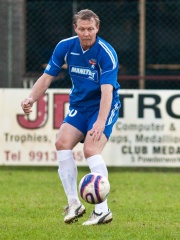
10. Matthew Bingley (b. 1971)
With an HPI of 53.40, Matthew Bingley is the 10th most famous Australian Soccer Player. His biography has been translated into 44 different languages.
Matthew Bingley (born 16 August 1971) is an Australian former soccer player. A utility who can play in midfield or defence, he has played over 300 matches in nearly 20 years at the highest level of domestic football in Australia. Bingley also made 14 appearances for the Australian national team, scoring five goals.
People
Pantheon has 170 people classified as Australian soccer players born between 1943 and 2003. Of these 170, 167 (98.24%) of them are still alive today. The most famous living Australian soccer players include Tim Cahill, Ned Zelic, and Zeljko Kalac. The most famous deceased Australian soccer players include Stephen Laybutt, Johnny Warren, and Dylan Tombides. As of April 2024, 10 new Australian soccer players have been added to Pantheon including Graeme Rutjes, Mark Bridge, and Billy Konstantinidis.
Living Australian Soccer Players
Go to all RankingsTim Cahill
1979 - Present
HPI: 65.51
Ned Zelic
1971 - Present
HPI: 56.17
Zeljko Kalac
1972 - Present
HPI: 55.64
Mark Schwarzer
1972 - Present
HPI: 55.48
Sam Kerr
1993 - Present
HPI: 54.65
Brad Jones
1982 - Present
HPI: 54.52
Mathew Ryan
1992 - Present
HPI: 54.12
Harry Kewell
1978 - Present
HPI: 53.90
Ante Covic
1975 - Present
HPI: 53.57
Matthew Bingley
1971 - Present
HPI: 53.40
Tony Popovic
1973 - Present
HPI: 52.74
Mark Viduka
1975 - Present
HPI: 52.66
Deceased Australian Soccer Players
Go to all RankingsStephen Laybutt
1977 - 2024
HPI: 51.90
Johnny Warren
1943 - 2004
HPI: 45.53
Dylan Tombides
1994 - 2014
HPI: 30.39
Newly Added Australian Soccer Players (2025)
Go to all RankingsGraeme Rutjes
1960 - Present
HPI: 48.75
Mark Bridge
1985 - Present
HPI: 31.79
Billy Konstantinidis
1986 - Present
HPI: 29.69
Erik Paartalu
1986 - Present
HPI: 29.10
Mackenzie Arnold
1994 - Present
HPI: 26.39
Katrina Gorry
1992 - Present
HPI: 25.30
Daniel De Silva
1997 - Present
HPI: 25.09
Matt Simon
1986 - Present
HPI: 24.01
Mary Fowler
2003 - Present
HPI: 22.30
Gethin Jones
1995 - Present
HPI: 21.90
Overlapping Lives
Which Soccer Players were alive at the same time? This visualization shows the lifespans of the 3 most globally memorable Soccer Players since 1700.

